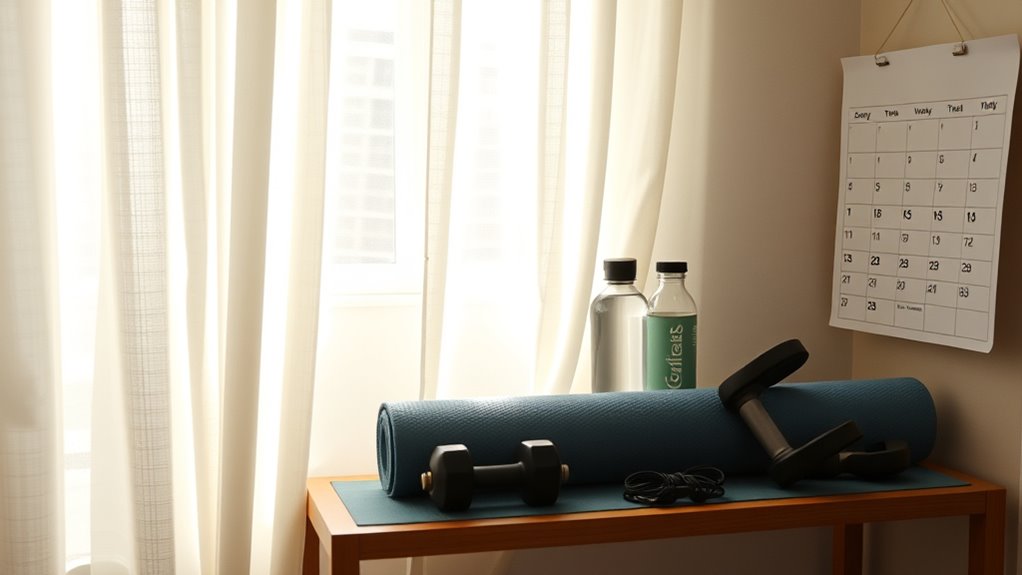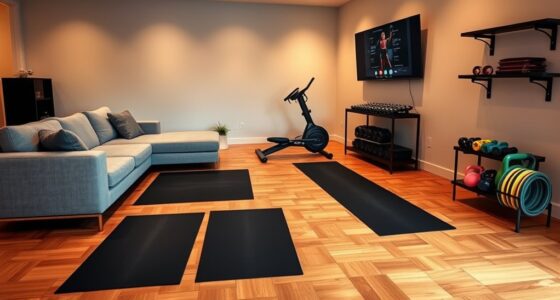To set realistic fitness goals, start by honestly evaluating your current strength, endurance, and overall health to understand your baseline. Define clear, specific objectives that are achievable within your lifestyle, and break larger goals into smaller steps to stay motivated. Establish a realistic timeline, celebrate progress along the way, and remain flexible to adjust goals as needed. Keep focus and commitment by tracking achievements—stick with it, and you’ll discover more about how to create sustainable success.
Key Takeaways
- Assess your current fitness level to establish a realistic starting point.
- Set specific, measurable, and achievable goals tailored to your abilities and resources.
- Break larger goals into smaller milestones to track progress effectively.
- Define clear deadlines and regularly review progress to stay motivated and adjust as needed.
- Focus on consistency and celebrate small wins to maintain motivation over the long term.
Assess Your Starting Point

Before you set any fitness goals, it’s important to honestly evaluate your current physical condition. Many people fall for fitness myths and common misconceptions, which can lead to unrealistic expectations. Take a good look at your strength, endurance, flexibility, and overall health. Be honest about your habits, routines, and current activity levels. Avoid comparing yourself to others or believing quick-fix solutions; progress takes time. Understanding where you stand helps you create achievable goals and prevents frustration later. Recognizing that everyone’s starting point is different, and that’s okay, is crucial. By appraising your baseline accurately, you set a solid foundation for your fitness journey and avoid the trap of setting goals based on myths or misconceptions about quick results or perfect bodies. Additionally, acknowledging your unique starting point allows you to tailor your approach to your specific needs and capabilities. Being aware of your initial fitness level can also inform your choice of exercises and intensity, making your efforts more effective and sustainable. Incorporating self-assessment techniques can further enhance your understanding of your progress and motivate continued effort. For example, understanding the Resources and Tools available, such as fitness trackers or professional assessments, can provide valuable insights into your development.
Define Clear and Specific Objectives

To set effective fitness goals, you need to define clear and specific objectives that guide your efforts. Focus on measurable outcomes, establish achievable milestones, and understand what motivates you to stay committed. These steps make sure your goals are realistic and keep you motivated along the way. Incorporating regular assessment and adjustment can help prevent stagnation and ensure your goals evolve with your progress. Additionally, drawing inspiration from creative parenting workshop ideas can foster innovative approaches to maintaining your motivation and staying engaged with your fitness journey. Recognizing signs of progress, such as increased strength or endurance, can further reinforce your commitment and help you adjust your objectives as needed.
Prioritize Measurable Outcomes
Focusing on measurable outcomes helps you stay motivated and track your progress effectively. When your goals include quantifiable results, you can use data visualization tools like charts or graphs to see your improvements clearly. This approach enhances goal specificity, making it easier to identify what works and what doesn’t. Instead of vague aims like “get stronger,” set precise targets like increasing your squat weight by 20 pounds within two months. Measurable outcomes turn abstract ambitions into concrete benchmarks, helping you stay accountable. By prioritizing these outcomes, you can adjust your routines based on actual progress rather than guesswork. Incorporating skin care strategies and maintaining proper hydration can further optimize your results and skin health. This clarity keeps you focused and committed, ensuring your efforts lead to meaningful results over time. Additionally, understanding how to employ cost-effective strategies can help you allocate resources efficiently and stay consistent with your fitness journey. Regularly reviewing your progress and setting new performance benchmarks ensures continuous improvement and keeps your motivation high. Engaging in appropriate recovery techniques can also prevent injuries and improve overall performance.
Set Achievable Milestones
Setting achievable milestones means breaking down your larger fitness goals into clear, specific objectives that are within your reach. Doing this provides motivation boosts and makes goal visualization easier. When you set small, manageable steps, you can celebrate progress along the way, keeping your momentum strong. Use the table below to help define your milestones:
| Short-term Goal | Specific Action |
|---|---|
| Run 3 miles steadily | Incorporate 2 weekly running sessions |
| Increase strength | Add 2 extra reps to each set during workouts |
| Improve flexibility | Attend a yoga class twice a week |
These milestones clarify your path, making formidable goals less overwhelming and more achievable. Additionally, exploring anime movies can provide fun inspiration and relaxation during your fitness journey. Incorporating a growth mindset can further enhance your motivation and resilience as you pursue your goals. Developing motivational skills can help you stay committed when faced with challenges. Recognizing the importance of targeted training can optimize your efforts and ensure steady progress.
Clarify Your Motivation
Have you ever wondered why some fitness goals feel more motivating than others? It’s often because of motivation clarity—knowing exactly why you want to achieve a goal helps fuel your purpose focus. When your objectives are clear and specific, you can visualize the benefits and stay committed during tough times. Take a moment to reflect on what truly drives you—whether it’s improving health, gaining strength, or boosting confidence. By clarifying your motivation, you turn a vague desire into a concrete reason that keeps you moving forward. This purpose focus sharpens your intent, making your goals more meaningful and attainable. When you understand your “why,” every step feels more purposeful, helping you stay motivated even when challenges arise.
Make Your Goals Measurable

To make your goals measurable, you need to track your progress regularly and celebrate small wins along the way. Setting clear milestones helps you stay motivated and see how far you’ve come. By monitoring your efforts, you can adjust your plan to stay on track and reach your ultimate fitness objectives. Incorporating skin care routines and air quality monitoring insights into your tracking methods can further enhance your progress. Additionally, understanding the benefits of eye patches, such as hydration and anti-aging effects, can serve as a reminder to prioritize self-care as part of your overall wellness journey.
Track Progress Regularly
How can you guarantee you’re making real progress toward your fitness goals? The key is tracking consistency and progress documentation. When you regularly record your workouts, weight, or other metrics, you gain a clear picture of your journey. This helps you spot patterns, stay motivated, and adjust your efforts as needed. Consistent tracking also prevents you from overlooking small improvements that add up over time. Use a journal, app, or calendar to note your workouts, reps, or measurements. The act of documenting keeps you accountable and provides tangible proof of your commitment. By making progress visible, you stay focused and motivated to push forward, ensuring your efforts align with your goals. Incorporating regular calibration of your metrics ensures your measurements remain accurate and meaningful. Regular tracking is essential for meaningful, lasting results, especially as arcade machines can vary in how they measure performance.
Set Clear Milestones
Setting clear milestones transforms your overall fitness goals into specific, measurable targets. When you break down big objectives into smaller milestones, you create motivation strategies that keep you focused. Visualizing these milestones helps you see progress clearly, boosting your confidence and commitment. For example, instead of just aiming to run faster, set a goal to run a 5K in a certain time within a month. Celebrate each achievement to stay motivated. Clear milestones make it easier to track progress and adjust your plan if needed. By making your goals measurable, you turn vague intentions into actionable steps. This approach not only keeps you motivated but also ensures you’re steadily moving toward your ultimate fitness aspirations.
Set Achievable and Realistic Targets

Achieving your fitness goals starts with setting targets that are both attainable and realistic. Avoid overambitious targets that can lead to frustration and burnout. Instead, focus on what’s achievable given your current fitness level, resources, and schedule. Unrealistic expectations often set you up for disappointment, so be honest with yourself about your capabilities. Break down big goals into smaller, manageable steps that you can realistically accomplish. This keeps you motivated and prevents discouragement. Remember, the goal is steady progress, not perfection. By setting achievable and realistic targets, you create a sustainable path toward your fitness success—one that encourages consistency and builds confidence along the way.
Establish a Timeline for Progress

Establishing a timeline for your progress provides clear deadlines that keep you focused and motivated. It helps you identify progress checkpoints along the way, so you can celebrate small victories and stay committed. While setting a timeline is important, remember to allow for flexibility; life can be unpredictable, and rigid deadlines might cause frustration. Adjust your timeline as needed, based on how your body responds and your daily schedule. This elasticity prevents burnout and keeps you engaged. Regularly reviewing your progress checkpoints ensures you’re on track without feeling overwhelmed. A realistic timeline balances ambition with practicality, giving you a roadmap that encourages consistent effort while accommodating life’s twists and turns. This approach keeps your motivation high and makes reaching your goals more achievable.
Break Down Larger Goals Into Smaller Steps

Breaking down larger fitness goals into smaller, manageable steps makes the journey less overwhelming and easier to track. When you set smaller milestones, it’s easier to stay motivated, and motivation techniques like celebrating small wins can boost your progress. Visualizing your goal helps you see the path clearly, making each step feel achievable. For example, instead of aiming to run a marathon right away, focus on running a mile, then gradually increase your distance. This approach keeps you engaged and provides a sense of accomplishment along the way. Breaking goals into steps creates a clear roadmap, helping you stay focused and motivated. Over time, these small successes build confidence and bring you closer to your ultimate fitness achievement.
Consider Your Lifestyle and Constraints

After setting smaller, manageable steps for your fitness goals, it’s important to reflect on how your lifestyle and daily commitments align with your plans. Your schedule likely includes time constraints that limit when you can work out, so choose times that fit naturally into your day. Consider your social commitments—family, friends, or work events—that might interfere with your routine. Being realistic helps you avoid frustration or skipped sessions. Adjust your goals to match busy periods or busy days, and plan workouts that can be completed in short, effective sessions if needed. By understanding your lifestyle, you’ll create a sustainable plan that fits seamlessly into your routine, increasing your chances of sticking with it long-term.
Stay Flexible and Adjust as Needed

Staying flexible and adjusting your plan as needed is key to maintaining progress and preventing frustration. Life is unpredictable, so adapting routines when circumstances change helps you stay on track. If you miss a workout or find an exercise isn’t working, don’t get discouraged—embrace change instead. Flexibility allows you to modify your goals or methods without feeling defeated. Listen to your body and recognize when you need rest or different approaches. Remember, fitness is a journey, not a rigid plan. By adapting routines, you keep yourself motivated and reduce the risk of burnout. Staying open to change ensures you remain committed while making progress at a sustainable pace. Flexibility is essential for long-term success and enjoyment in your fitness journey.
Celebrate Progress and Reassess Goals

Celebrating your progress is essential because it reinforces your motivation and keeps you focused on your goals. Recognizing your achievements with reward recognition boosts confidence and makes progress feel meaningful. Regularly reassessing your goals helps you stay aligned with your evolving abilities and interests. To effectively celebrate and reassess:
- Acknowledge small wins to maintain momentum.
- Use goal visualization to see how far you’ve come.
- Adjust your goals based on your progress and new insights.
- Reward yourself with something motivating, like new workout gear or a rest day.
Frequently Asked Questions
How Often Should I Reevaluate My Fitness Goals?
You should reevaluate your fitness goals every 4 to 6 weeks, depending on your progress tracking. Regular check-ins help you stay motivated and identify when goal adjustments are needed. If you’re hitting milestones easily, consider setting new challenges. Conversely, if progress stalls, reassess your approach. Staying flexible guarantees your goals remain realistic and achievable, keeping you motivated and on track toward your overall fitness journey.
What Should I Do if I Hit a Plateau?
Remember, “a smooth sea never made a skilled sailor.” When you hit a plateau, it’s time for plateau prevention and goal adjustment. Mix up your workouts, increase intensity, or try new exercises to break through stagnation. Reassess your goals, stay committed, and be patient. Progress isn’t always linear, but with persistence and smart tweaks, you’ll continue moving forward toward your fitness aspirations.
How Can I Stay Motivated Long-Term?
To stay motivated long-term, you need motivation boosters like rewarding small achievements and tracking progress. Find accountability partners who encourage you and keep you honest. Mix up your workouts to prevent boredom and set new challenges to maintain excitement. Remember, consistency beats intensity. Celebrate your successes, no matter how small, and remind yourself of your reasons for starting. This keeps your motivation high and helps you stick to your fitness journey.
Are These Goal-Setting Strategies Suitable for Beginners?
Research shows that clear, specific goals boost motivation, especially for beginners. Your strategies involving goal specificity and initial assessments are suitable because they help you stay focused and track progress. By setting realistic, achievable targets early on, you build confidence and stay committed longer. These approaches are perfect for beginners, as they create a solid foundation, making your fitness journey more manageable and enjoyable from the start.
How Do I Balance Fitness Goals With a Busy Schedule?
Balancing fitness goals with a busy schedule requires smart time management and priority setting. You should carve out specific times for workouts, even if they’re short, and treat them as non-negotiable appointments. Focus on prioritizing your health and fitness, making it part of your daily routine. By effectively managing your time and setting clear priorities, you can stay committed to your fitness goals without feeling overwhelmed.
Conclusion
Remember, setting realistic fitness goals is like planting seeds in a garden—you need patience, care, and flexibility to see them bloom. By starting small, adjusting as you grow, and celebrating each milestone, you’ll nurture a journey that’s as rewarding as a sunrise after a long night. Keep your eyes on the horizon, but stay present in each step, knowing that every effort is a brushstroke in the masterpiece of your healthier, stronger self.









